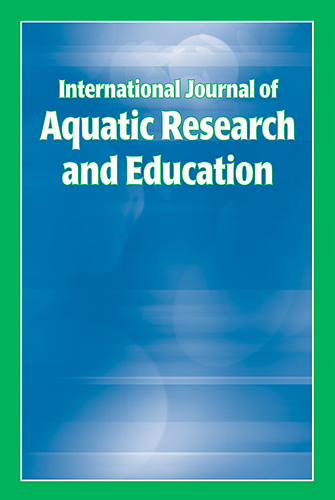Home > Journals > IJARE > Vol. 12 > No. 2 (March 2020)
Volume 12, Number 2 (March 2020) Volume 12, Issue 2
In This Issue 12(2)
Welcome to the second issue of the 12th volume of the international Journal of Aquatic Research and Education
Research Articles
The first research article in this second issue was authored by Ana Ortiz-Olivar. from Uruguay. Her article, "Creativity, Experience, and Reflection: One Magic Formula to Develop Preventive Water Competences," describes an investigation into water competence by 9-10-year-olds from five schools. The purpose of her experimental curriculum was to focus on how to get the students to be water competent in open water settings that they sought out.
The second research article in this issue comes from Billy Doyle and Jonathan Webber, both from New Zealand. Their article, "Towards a “Rescue Ready” Mindset: Can Lifeguard Teams Learn Lessons from the Attributes of Chronic Unease?" addresses a fascinating aspect of lifeguard teams.
A third research paper comes to IJARE from Brazil and Portugal. The authors, David Szpilman, Danielli Mello, Ana Catarina Queiroga, and Rogerio Ferreira Emygdio, have presented a fascinating study covering 36 years of Brazilian drownings, both before and after the establishment of the SOBRASA lifesaving organization. The paper, "Association of Drowning Mortality with Preventive Interventions: A Quarter of a Million Deaths Evaluation in Brazil," is an in-depth study on the impact that drowning prevention programs may have on the fatal drowning rating using a new measure that authors have called the "drowning water safety score” (DSS). This innovative new measure may become a new standard in understanding drowning prevention efforts.
A fourth research paper, "Examining group differences in emotion regulation strategies and the state and trait anxiety of fifeguards and non-lifeguards in a real-world precompetitive situation," was authored by Hannah Calverley (Federation University (AUS) & Northumbria University (UK), Paul Davis (Umea Universitet), Jack Harvey (Federation University), and Christopher Mesagno (Federation University). This paper explored the differences between lifeguards and non-lifeguards on their emotional strategies as well as both state and trait anxiety.
A fifth paper comes from Anna L. Forde and Emily A Zeman (both of MGH Institute of Health Professions) plus Lynn Clarke (City of Naples). The paper, "Effectiveness of an Intensive Drowning Prevention Program and Skills Retention by Children with and without Disabilities," examined an intensive swim program, SWIM Central, that examined how children with and without disabilities gained swim skills and drowning prevention skills.p
A sixth research paper, "Drowning of Pet Owners during Attempted Animal Rescues: The AVIR-A Syndrome," comes from Australia, authored by John Pearn (The University of Queensland, Royal Life Saving Society - Australia), Amy Pelen (Royal Life Saving Society - Australia; James Cook University, UNSW Sydney), and Richard Franklin (James Cook University; Royal Life Saving Society - Australia). I found it to be a fascinating article that expands upon the notion of rescue altruism (i.e., ignoring the danger to oneself in rescuing someone or something).
A final research article in this issue comes from William A. Koon (University of New South Wales, Sydney, Australia + California State Parks), Ryan M. Gates (California State Parks), and Jack Futoran (California State Parks). It is an extensive and lengthy evaluation of the comprehensive training that California State Park lifeguards undergo. Titled as "Training Evaluation for Introductory Ocean Lifeguard Instruction: A Practical Example from California," I believe other agencies who train lifeguards will find the results of their survey to be instructive in improving lifeguard training.
Scientific Literature Reviews
The final two articles in this issue are scientific literature reviews on aquatic topics. The first review, perhaps the longest and most comprehensive we have ever published in IJARE, was conducted by Muthia Cenderadewi (the University of Mataram, Indonesia), Richard Franklin, and Sue Devine (all from James Cook University, Australia) under the title, "Socio-Ecological Nature of Drowning in Low- and Middle-Income Countries: A Review to Inform Health Promotion Approaches." It is a phenomenal exhaustive review examining unintentional drownings in low- and middle-income countries (LMIC) that I predict may become an important resource for others involved in studying drowning prevention.
The second literature review was conducted by Hannah Calverley, Lauren Petrass, and Jenny Blitvich (all from Federation University, Australia) and was titled "Alcohol-Focused Drowning Prevention Campaigns: What Do We Know and What Should We Do Now?" It is a concise and well accomplished literature review examining the role that alcohol plays in drowning and drowning prevention. It makes a nice contribution to the aquatic and drowning prevention literature.
Happy reading of these excellent and varied aquatic articles.
Research Articles
Creativity, Experience, and Reflection: One Magic Formula to Develop Preventive Water Competences
Ana I. Ortiz Olivar
Towards a “Rescue Ready” Mindset: Can Lifeguard Teams Learn Lessons from the Attributes of Chronic Unease?
Billy RJ Doyle and Jonathon Webber
Examining Group Differences in Emotion Regulation Strategies and the State and Trait Anxiety of Lifeguards and Non-Lifeguards in a Real-World Precompetitive Situation
Hannah Calverley, Dr Paul Davis, Dr Jack Harvey, and Dr Christopher Mesagno
Association of Drowning Mortality with Preventive Interventions: A Quarter of a Million Deaths Evaluation in Brazil
David Szpilman, Danielli B. Mello, Ana Catarina Queiroga, and Rogerio Ferreira Emygdio RFE
Effectiveness of an Intensive Drowning Prevention Program and Skills Retention by Children with and without Disabilities
Anna L. Forde OTD, OTR/L, CTRS; Emily A. Zeman OTD, MS, OTR/L; and Lynn Clarke
Drowning of Pet Owners during Attempted Animal Rescues: The AVIR-A Syndrome
John Pearn, Amy E. Peden, and Richard Charles Franklin
Training Evaluation for Introductory Ocean Lifeguard Instruction: A Practical Example from California
William A. Koon, Ryan M. Gates, and Jack Futoran
Scientific Literature Reviews
Socio-Ecological Nature of Drowning in Low- and Middle-Income Countries: A Review to Inform Health Promotion Approaches
Muthia Cenderadewi, Richard Charles Franklin, and Susan Devine
Alcohol_Focused Drowning Prevention Campaigns: What Do We Know and What Should We Do Now?
Hannah Calverley, Lauren Petrass, and Jennifer Blitvich
